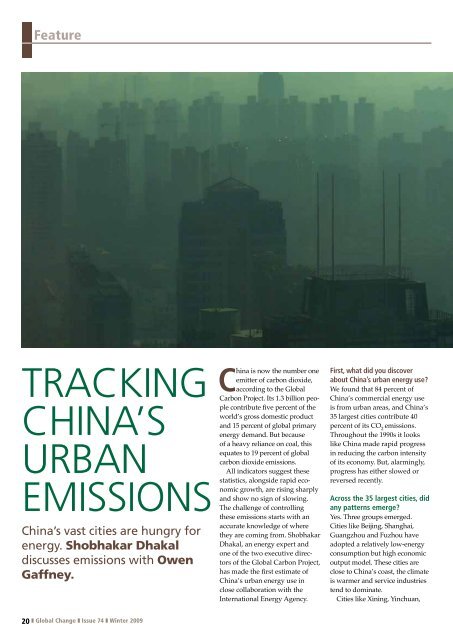Planetary boundarIes
Planetary boundarIes
Planetary boundarIes
You also want an ePaper? Increase the reach of your titles
YUMPU automatically turns print PDFs into web optimized ePapers that Google loves.
Feature<br />
Tracking<br />
china’s<br />
urban<br />
emissions<br />
China’s vast cities are hungry for<br />
energy. Shobhakar dhakal<br />
discusses emissions with Owen<br />
Gaffney.<br />
20 ❚ Global Change ❚ Issue 74 ❚ Winter 2009<br />
need real photograph<br />
of shanghai<br />
China is now the number one<br />
emitter of carbon dioxide,<br />
according to the Global<br />
carbon Project. Its 1.3 billion people<br />
contribute five percent of the<br />
world’s gross domestic product<br />
and 15 percent of global primary<br />
energy demand. But because<br />
of a heavy reliance on coal, this<br />
equates to 19 percent of global<br />
carbon dioxide emissions.<br />
all indicators suggest these<br />
statistics, alongside rapid economic<br />
growth, are rising sharply<br />
and show no sign of slowing.<br />
The challenge of controlling<br />
these emissions starts with an<br />
accurate knowledge of where<br />
they are coming from. shobhakar<br />
Dhakal, an energy expert and<br />
one of the two executive directors<br />
of the Global carbon Project,<br />
has made the first estimate of<br />
china’s urban energy use in<br />
close collaboration with the<br />
International energy agency.<br />
first, what did you discover<br />
about China’s urban energy use?<br />
We found that 84 percent of<br />
china’s commercial energy use<br />
is from urban areas, and china’s<br />
35 largest cities contribute 40<br />
percent of its co 2 emissions.<br />
Throughout the 1990s it looks<br />
like china made rapid progress<br />
in reducing the carbon intensity<br />
of its economy. But, alarmingly,<br />
progress has either slowed or<br />
reversed recently.<br />
Across the 35 largest cities, did<br />
any patterns emerge?<br />
Yes. Three groups emerged.<br />
cities like Beijing, shanghai,<br />
Guangzhou and Fuzhou have<br />
adopted a relatively low-energy<br />
consumption but high economic<br />
output model. These cities are<br />
close to china’s coast, the climate<br />
is warmer and service industries<br />
tend to dominate.<br />
cities like Xining, Yinchuan,

















